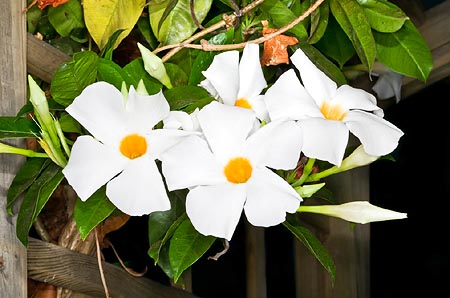Family : Apocynaceae

Text © Pietro Puccio

English translation by Mario Beltramini

Tropical climber. Doesn’t love temperatures close to 0° C © Giuseppe Mazza
The Mandevilla boliviensis (Hook.f.) Woodson (1933) is native of Costa Rica, Colombia, Venezuela, Ecuador, Peru, Bolivia and Brazil.
The genus was honoured to Henry John Mandeville (1773-1861), who was British consul in Buenos Aires and introduced many species in Europe; the name of the species refers to one of its areas of origin.
Common names: “white dipladenia”, “Mandevilla summer snow” (English); “dipladénia blanc”, “dipladénia de Bolivie” (French); “dipladenia blanca (Spanish); “neve do verao” (Portuguese).
Woody vine of evergreen sarmentose shrub, with stems which can be 4 metres tall, it shows oblong or elliptical leaves of a glossy dark green colour, long up to about 10 cm; the terminal or axillar inflorescences carry 3-4 funnel-shaped white flowers with yellow throat, slightly perfumed, with a diameter of 6-8 cm. The fruits are oblong follicles containing many seeds provided with a tuft of hair which favour their dispersal. It reproduces by seed, by herbaceous cutting in spring or semi-woody in summer.
Plant which can be cultivated in tropical, subtropical and, marginally, warm-temperate climates areas, as it does not bear temperatures around the 0°C, elsewhere it can be cultivated in pot, in order to be sheltered in winter. It prefers an exposition in full sun or slightly shaded and acid or neutral soils, well drained and kept humid. All the parts of the plant are poisonous if ingested, as it usually happens for the plants belonging to the family of the Apocynaceae; the sap can cause rashes.
Synonyms: Dipladenia boliviensis Hook.f. (1869); Dipladenia bella Pittier (1931); Mandevilla bella (Pittier) Woodson (1933); Mandevilla pittieri Woodson (1936).
→ To appreciate the biodiversity within the APOCYNACEAE family please click here.
